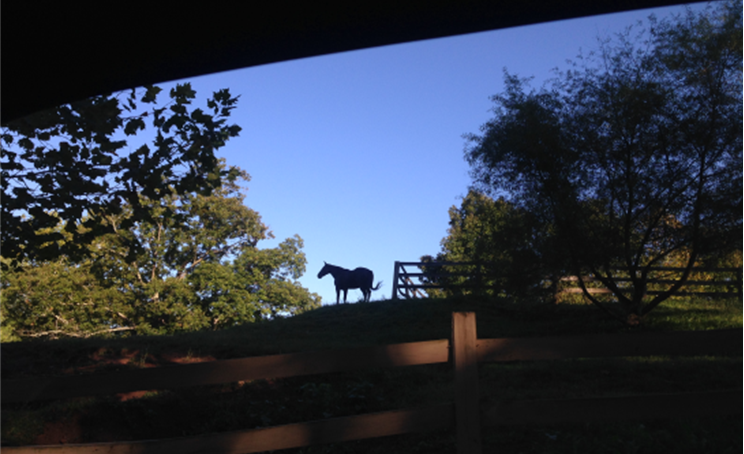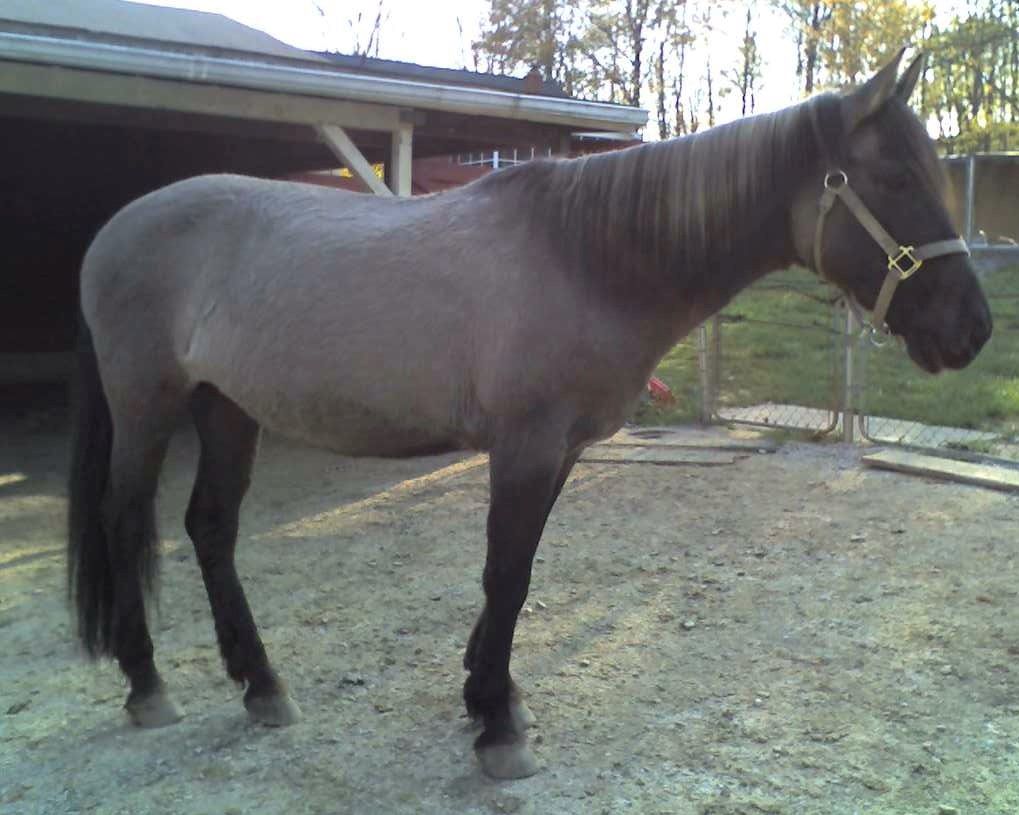Lightning – Equine Storyteller

Lightning Begins Maggie’s Story
Lightning was half dozing, standing under the story tree with several members of her herd. She swished her tail half-heartedly, more out of habit than to chase the stray fly. She was standing head-to-tail with Patches, her current best buddy. Herd etiquette called for flipping her tail occasionally over Patches’ face to chase any annoying flies.
Half awake, Lightning found herself thinking about Maggie. How she still missed Maggie, and how life was simpler when Maggie was herd leader of the back field at the rescue farm. Maggie left the field about two years earlier, when she died peacefully at 35 years of age.
Maggie had been at Random Canyon Rescue when Lightning arrived, and had become Lightning’s leader, teacher and friend. She was an easy herd leader to follow, and Lightning tried to be like Maggie now that leadership had passed to her. It had been a very long time since any horse initiated a challenge to Lightning’s leadership. The horses currently in the herd seemed happy enough with her role. She was expected to lead them to the barn each feeding and out to pasture or to the hay feeders afterward. Otherwise, they were all comfortable enough with the routines to independently wander the pasture, get a drink from the water troughs, or seek a spot to roll or doze. They may look to her for reaction to noises or weather conditions, but were mostly content.
Maggie was a grullo or dun mare, and a storyteller in her own right. Lightning had learned a significant number of her stories from Maggie.
Maggie’s Own Story
Maggie’s own story began on a huge working cattle ranch. She was born in the vast wide open acres of Montana. She spent her first year on high ranges with her mother’s band of horses. While they were not wild horses, they were permitted to be as free as possible, yet in a semi-controlled range.
There were about 25 mares in the band and the spring Maggie was born there were 18 other foals. They grew strong and fast, and raced endlessly.
The mares taught them to respect the herd, to understand social skills and to notice the slightest changes in their surroundings. These young colts and fillies developed lightning quick reflexes and strength to match. As their bones and muscles grew, they were also learning to control their wild gallops and kicking play.
Living on the open Montana range wears off the foal hoof wall naturally and develops a wide functional frog and strong thick sole. This early strengthening would create the basis for a lifetime of strong healthy hooves, as long as they received good care and nutrition.
Maggie’s second summer was spent closer to the main ranch complex with a group of fillies close to her age. These youngsters were handled, halter trained and taught ground work, but still largely lived together as a herd, now challenging one another for status. That fall, they were returned to a range herd, along with the now gelded colts. Maggie and the others continued to grow strong and sturdy. By their third summer, many of the young horses had been sold to other ranches, but Maggie was kept for further training as a ranch horse.
She was trained in a traditional ranch style; a little gentling followed by lots of saddle time. The first cowboy assigned to train her had quite a few other horses in his remuda, or string, of horses, so she worked hard, but was never overworked. Maggie’s trainer had gentle hands and knew how to use his spurs on his mounts so they rarely felt more than a nudge. He laughed a lot and sang loudly on the open range. Maggie came to enjoy working the cows with the cowboys and their mounts.
Maggie’s next five years were filled with much the same routine. Lots of year around ranch work, but excellent care. She became a solid cutting horse. Though she worked with different riders, they were all experienced and most were kind, with only a few exceptions. Maggie’s trust in humans was firmly established in those years.
When she was nine years old, Maggie was sold at a ranch stock sale to a group of friends who followed the rodeo circuit. Maggie was precise in her handling of the cows, and could cut the most stubborn steer from a milling bunch. Even so, she was not quick enough to do well in some of the roping and bull dogging competitions. Her owners weren’t really mean to her, but they were driven to win. They saw this mare and the other horses they owned as just a means to the end of winning. They pushed their horses to extremes, believing that more forceful treatment would create more speed. And that more force would push the horse to try harder. After her second season with the rodeo riders, they traded her for another horse. The horse they got in trade had more speed, though much less experience.
Maggie’s new owner was a very inexperienced rider, but he was determined to learn to rodeo. Unfortunately, he had rough hands and was always yanking on her mouth and neck. At the same time he pounded on her sides with his stylish harsh spurs. As many experienced horse do in this kind of environment, Maggie shut down and stoically accepted her rider’s unintentional abuses. When a horse withdraws and shuts down, they often become slower and lose the edge that is needed for cutting and reining work. Maggie never fought back; her early training was too much a solid part of her. But, before long, Maggie was on her way to another owner.
There are many folks who get horses who would be better served by owning a motorized four-wheeler. They ride with no regard to the welfare of the horse. Sometimes they will let their horses stand for days, weeks or even months in a cramped barn stall. The horse is fed, but gets no exercise. Then the absentee owner will appear with their friends and will ride all day. They will ride hard and fast, with no regard to the hills and rugged terrain. Maggie suffered a series of such owners, and developed some chronic pain issues as a result. These riders tend to trade horses often, believing they just haven’t found the right horse for their needs.
Eventually, the Woman who owned Random Canyon Rehab found Maggie at an auction. Seeing so much history in the old mare’s eyes and demeanor, the Woman knew she had a job for her at the farm. The mare’s true name had been lost and changed many times by that time. The Woman called her Maggie, and for almost 10 years she helped train horses being rehabbed. She also took charge of the herd in the back field. There she met Lightning and the two became fast friends. Maggie lived out the rest of her days in the comfort of the rescue. Once again knowing only the kind hands of the Woman.
Ranch Horse Training
As Lightning relates Maggies’ story, she talks briefly about traditional ranch horse training. Maggie was trained using the more progressive methods that intend to develop a horse into a solid, confident partner for working cattle, fence and range duties.
The horses are allowed to mature in a herd, then are trained with work as the goal. While there are probably no two ranches that train the same, the desired outcome is for a healthy, strong, agile, thinking horse. Much of this training is OJT (on the job); as the cowboy goes about his ranch tasks, he is also training. He will teach his mounts to neck rein, because he often needs a hand free to use his rope. He wants his horses to learn to react instantly to the movements of a wily steer, so he grants them the independence to think and react while he maintains a deep secure seat in a cowman’s saddle.
As we will learn in future stories, not all ranches use these methods, but we hope more are adopting caring ways.

Follow Lightning’s stories about the horses at Random Canyon Rehab at my website: https://www.RandomCanyonCrafts.com. Sign up for my newsletter to get notified when Lightning adds a new story! Glad you are following. Please let her know what you think of these stories by leaving her a comment.